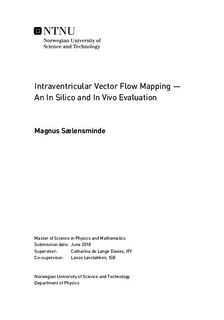Intraventricular Vector Flow Mapping ― An In Silico and In Vivo Evaluation
Master thesis
Permanent lenke
http://hdl.handle.net/11250/2564453Utgivelsesdato
2018Metadata
Vis full innførselSamlinger
- Institutt for fysikk [2677]
Sammendrag
Modern cardiology research aims to encompass sophisticated analysis of intraventricular blood flow in the clinical practice. Such analysis relies on robust and effective means of measuring blood flow fields, an approach also known as vector flow imaging (VFI). Because cardiovascular disease is the leading cause of death globally, and ultrasound is the most used imaging modality in cardiology, finding new and improved echocardiographic VFI techniques has huge potential benefits.
This master thesis concerns the development and evaluation of a Doppler based VFI technique called intraventricular vector flow mapping (iVFM). iVFM is a two-dimensional VFI method by Assi et al. that formulates and solves a regularized linear minimization problem with Doppler and wall data as inputs.
The iVFM method was implemented in the visualization pipeline of the ultrasound viewer named PyUSView, which was used as a platform for in silico and in vivo studies that covered a comparison between iVFM, speckle tracking (ST) and an a combined method. Two proposed iVFM improvements were also subject to analysis: One that restricts artificial radial flows by addition of a new regularization term and another that shows how it is possible to include out-of-plane-flow in iVFM.
The results outline some of the differences between ST and iVFM, and shows that a combination of the two methods produces results that harvest strengths from both. The new regularization term proved effective in the suppression of artificial radial flows outside the color Doppler mask, and the out-of-plane flow gradient analysis showed a large potential for error reductions.
